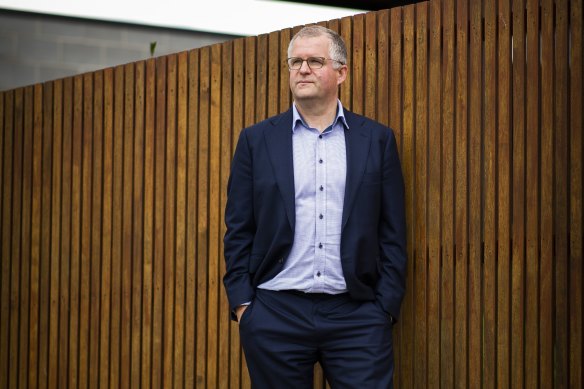Three Victorian vice chancellors paid $1 million-plus, despite uni deficits

Save articles for later
Add articles to your saved list and come back to them any time.
Three Victorian university vice chancellors earned more than $1 million last year, and three received six-figure salary increases, despite all eight universities posting deficits as the pandemic continued to weigh on their finances.
Vice chancellors at Monash, Deakin and La Trobe universities had salary increases of more than $100,000 last year, their annual reports reveal, either because pay cuts they took in 2020 and 2021 were phased out, or because they again claimed large executive bonuses they did not accept at the height of the pandemic, when universities were shedding thousands of jobs.
Victoria’s three highest-paid vice chancellors (L-R): Pascale Quester of Swinburne University, Margaret Gardner of Monash University and Duncan Maskell of the University of Melbourne.Credit: The Age
Only one of Victoria’s eight vice chancellors, Swinburne’s Professor Pascale Quester, took a pay cut last year, even as the state’s universities posted deficits that tallied beyond a combined $507 million.
The Australian Association of University Professors argues that vice chancellor salaries have become wildly excessive and should be slashed.
Most Victorian vice chancellors earn at least twice as much, and in some cases three times as much, as the annual salary of Victorian Premier Daniel Andrews, who is Australia’s highest-paid premier.
Monash University’s Professor Margaret Gardner pocketed a 12 per cent pay rise of roughly $140,000, taking her total remuneration to a range between $1.37 million and $1.38 million.
Deakin University vice chancellor Professor Iain Martin claimed a $150,000 performance bonus this year, having chosen not to accept it in 2021.Credit: Paul Jeffers
A Monash spokesperson said Gardner has no involvement in determining her remuneration, which is reviewed annually by a committee of the university council.
“The reported remuneration in 2021 reflected a component of a 20 per cent remuneration reduction – that the vice chancellor voluntarily initiated and agreed to – as part of the university’s response to the financial impact of COVID-19 to the university,” the spokesperson said.
Monash posted a $113 million deficit this year, but also donated $116 million to its own Monash Foundation, a charity that earns investment income for the university.
The university is negotiating a new enterprise agreement with staff and has offered a 10 per cent pay increase over three years, including 4 per cent this year.
The National Tertiary Education Union’s Monash branch president, Dr Ben Eltham, said the fact that Monash could afford to make a $116 million donation to its own charity revealed “their finances are in rude health”.
“This is why management are back on the gravy train,” he said. “It’s significant that [Gardner’s] pay rise is 12 per cent but the offer she has put to staff is 4 per cent.”
The university said the Monash Foundation supports community engagement, including providing scholarships to young people in low socioeconomic areas, and students volunteering in bushfire-affected areas.
Melbourne, Deakin, La Trobe and Federation universities are also bargaining with staff over enterprise agreements. Thousands of staff went on strike and rallied in inner Melbourne earlier this month, calling for bigger pay rises and a reduction in universities’ reliance on casual labour.
Deakin University vice chancellor Iain Martin had a similarly large-scale pay rise of $130,000 last year, taking his pay to a range between $980,000 and $990,000, while La Trobe’s John Dewar had a $100,000 pay rise compared to 2021.
The salary of Martin – who was reappointed for another five years in March – was larger in 2022 because he did not accept an incentive bonus in 2021, Deakin University’s annual report states. The incentive payment totalled $150,750.
La Trobe University’s annual report states that Dewar’s salary was not an increase, but a reinstatement of the salary he was on before he took a 20 per cent, COVID-era pay cut for 12 months, as part of a university-wide effort to limit job losses. Dewar has announced he will step down as vice chancellor in January 2024 after 12 years in the role.
Swinburne’s Quester took a $20,000 pay cut last year but was one of three university heads whose salary package exceeded $1 million, with the former University of Adelaide leader earning about $1.03 million.
University of Melbourne vice chancellor Professor Duncan Maskell did not get a pay rise last year but remained the state’s highest-paid university leader, with a remuneration package of between $1.5 million and $1.515 million.
According to the University of Melbourne’s annual report, Maskell’s salary package includes a fringe benefit associated with a residence owned by the university. The residence is regularly used for official university functions and has a fringe-benefit value of $301,541.
Professor Alec Cameron, who commenced as vice chancellor of RMIT University early in 2022, earned a salary between $940,000 and $950,000, which was less than his predecessor, Professor Martin Bean.
Victoria University’s Professor Adam Shoemaker, the state’s lowest-paid vice chancellor, earned $810,000 to $820,000 last year.
In a submission to the Albanese government’s university accord, the Australian Association of University Professors argues salaries should be capped at roughly twice that of a senior professor. Senior academics can earn $200,000 a year or more.
“All salaries of the executive officers of Australian public universities – including, but not limited to, vice chancellors – must be aligned with those of other leaders of public institutions and capped at twice a professorial salary,” the submission states.
James Guthrie, the association’s treasurer and a distinguished professor of accounting at Macquarie University’s business school, said Australian vice chancellors’ salaries were scandalous.
“We think they are very generous,” Guthrie said.
The Morning Edition newsletter is our guide to the day’s most important and interesting stories, analysis and insights. Sign up here.
Most Viewed in National
From our partners
Source: Read Full Article


